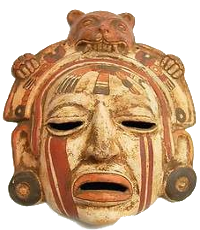Huacas, ceque and nazca lines
Huaca is the Quechua word for a “revered object.” In Inca society it referred to a monument or a feature of nature where an energy of some kind had gathered, perhaps a cosmic force or an emanation of the divine. In order to harness that energy, and placate the gods, people would conduct ceremonies at the huacas, making offerings and saying prayers. Members of a particular family would often have the task of looking after a particular location. Huacas existed already in pre-Incan societies and they exist all over Peru to this day. Indeed, down-town Lima has been built around them.
Different huacas were joined together in pathways known as ceques. The ceques would run throughout the landscape conducting spiritual energy from one place to another. Together they formed a pattern which radiated out from the capital of Cusco to every part of the empire. When children were dispatched to various places of sacrifice, they were located according to the ceque system. [Read more: “Children of the mountain“] Together these lines formed a spiritual grid in which all imperial subjects could find their place and through which they all were connected. By conducting the required rituals at a huaca each conquered people could show that they accepted the power of the Inca rulers. In this way the ceque brought a sense of unity to a geographically very dispersed set of subjects.
Nazca lines are enormous geoglyphs, “earth engravings,” created by the Nazca people some time between 500 BCE and 500 CE. [Read more: “Kingdoms of Peru“] They consist of trenches, 10 to 15 centimeters deep, which create a line-drawing in the landscape. And they are enormous – up to one kilometer tall. Popular motifs are animals or humanoid forms. Why the Nazca lines were created is unclear. Perhaps they were a part of an irrigation system or perhaps they played some role in an astronomical calendar. Curiously many of them are best viewed from the sky, leading to speculations that they were a way for the Nazca people to communicate with extra-terrestrials. Nazca lines are a favorite subject of late-night documentaries on less reputable TV channels.
External links
- Alfred Watkins, “The old straight track : its mounds, beacons, moats, sites, and markstones,” 1948
- Brian S. Bauer, Sacred landscape of the inca: the cusco ceque system, 2011
- Discover Peru, “Nazca lines”
- Erich von Däniken, ” Geoglyphs and worldwide geometrical symbols”
- Graham Hancock, “The Enchanting Landscape of Cusco: a Study in Pre-Columbian Geomancy”
- Lost Science of the Andes, “A geomantic history of South America”
- National Geographic, “Exclusive: Massive Ancient Drawings Found in Peruvian Desert”
- R. Tom Zuidema, The ceque system of Cuzco : the social organization of the capital of the Inca, 1964
- TV Peru, “Las huacas de Lima”
- William Sullivan, “Secrets of the Incas: Myth, Astronomy and the War Against Time”
- YouTube, “Nazca lines finally solved”

